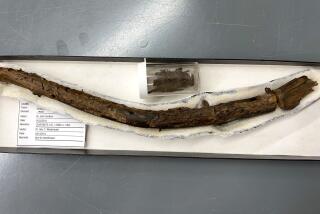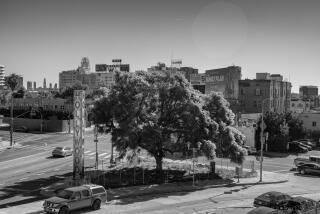Basking in acacias’ glow
Thank goodness for Australian acacias, the winter wonders from Down Under. On these dank days, even from afar, their golden glow is unmistakable.
On closer inspection, the contrast between leaf and flower is startling. Billowing masses of small, fluffy blossoms play against elegant, sometimes curious green or gray foliage.
Several kinds of “wattles,” as the Aussies call them, are so common here that people think they’re native. But they’re not.
In fact, Australian plants showed up in California in the 1850s. Acacias were among the most versatile, with uses in perfume, for cutting and as ornamentals. They thrived in settings north to south.
Municipalities sported avenues of stately acacia trees. “In 1931,” writes the late Victoria Padilla in her book “Southern California Gardens,” “acacias constituted one-fifth of all the street tree plantings in Los Angeles.”
Unfortunately, because acacias are relatively short-lived (20 years if they’re lucky), few, if any, of those trees remain. The lack of longevity, and the reality that certain acacias become brittle or invasive, can be discouraging. Still, the negatives are offset by their speedy growth and bountiful color.
Australian acacias are fast and cheap, and, though a few may be out of control, they’re a perfect winter complement to the Southern California palette. They carpet highway embankments and grace fine gardens. And new species and cultivars are offered each year, a trend not likely to fade.
Kathy Musial, curator of living collections at the Huntington Botanical Gardens, is a Los Angeles native, but Australian plants are one of her specialties. She’s familiar with many of the more than 900 species of Australian acacias.
“Though most flower in winter, they’re extremely varied and come from all kinds of habitats,” Musial says. Many, including some tall tree acacias, are understory plants in eucalyptus forests, so they tolerate and even prefer some shade, she adds.
But, as pioneering Californians noted, they are amazingly adaptable. Many take considerable sun and heat. Those from the Australian rain forest may survive in dry gardens, and those from arid climes can thrive with regular irrigation.
Jo O’Connell of Australian Native Plants Nursery in Ventura cites one example, the shoestring acacia, Acacia stenophylla. Though used in dry gardens here, it grows near creeks in Australia.
Wattles are unique in many ways, not the least of which is their Monty Python-esque nickname, derived from a British building technique used by early settlers. In the land of the wombat berry and the wonga wonga vine, what could one expect?
O’Connell, a horticulturist from Sydney, relates many indigenous uses for wattles, for tanning, dyeing and as boomerang wood. Many parts are used for food. The flowers of hairy wattle, A. vestita, are used in fritters, and the protein-rich seeds of elegant acacia, A. victoriae, are ground into flour. (O’Connell even has a recipe for wattle seed Pavlova. “Who could resist?” she asks.)
Wild wattles are pioneer species, among the first plants to sprout after a fire. Their rapid growth and shallow roots break ground for larger forest trees. As nurse plants, they provide shade and wind protection for seedlings.
Acacia leaf shapes are distinctive and run the gamut. The delightful blossoms, usually yellow and produced in awesome numbers, are either fuzzy little balls or held in rod-shaped clusters. Most are scented, a few more pleasantly than others.
Tree acacias, small and large, are impressive, especially when in bloom. Many wattles are graceful weepers, lovely alone or planted en masse.
Large shrubby acacias promise what many gardeners crave: quick cover, or a nearly instant screen. Small-scale shrubs may be dense or open; spreading ones make terrific ground covers. Spiny wattles do double duty as barriers and bird refuges.
Wattles are also prized for use in arrangements. Ben Gill of California Protea Management in Valley Center grows scores of Australians for the cut flower market, including several types of acacias.
Gill cuts all year, as florists prefer foliage only -- that is, boughs without flowers. “There’s a different texture, without the yellow,” he says. “It allows designers more leeway with the leaf colors.”
In the garden, one thing that all acacias appreciate is good drainage. “No amendments,” says O’Connell. “If your soil is really heavy, mound it up. And no feeding. Just a nice organic leaf mulch.”
But what about that life span? Musial expects 15 years before most trees decline, even less for shrubs. “Fast-growing plants generally lead shorter lives,” she says.
Lucky for us, replacements are getting easier to find, with more growers trying their hand. In addition, Musial says Australian acacias are easy to grow from seed and can be started anytime.
Wait until the soil is dry enough to work, then consider adding a wattle or two. Come Sept. 1, National Wattle Day in Australia, fire up the barbie and say a toast to the folks Down Under.
*
(Begin Text of Infobox)
For color and contrast
Illuminate your winter landscape with Australian acacias. Those listed with a (C) are good for cut arrangements.
TREES
Mudgee wattle, A. spectabilis. An open 12-footer from Aussie wine country. Ferny green leaves and bright yellow blossoms.
Pearl acacia, A. podalyriifolia. To 20 feet, with rounded silver-gray leaf stems and deliciously fragrant flowers. (C)
Fern-leaf acacia, A. baileyana. Fairly common. To 25 feet, with huge honey-scented trusses in winter. The new growth of A. b. purpurea is violet-tinged. (C)
Silver wattle, A. o’shanesii. A stunner to 40 feet, with pendulous branches, feathery silver-backed limy-green foliage and highly perfumed flowers.
Weeping myall, A. pendula. To 20 feet, with shimmering narrow blue-gray foliage and bright pale yellow flowers. (“Myall” is a term for Australian desert acacias.)
SHRUBS
Golden wattle, A. longifolia. Conspicuous along local freeways. Big (10 feet plus), mounding and green, with copious rod-shaped flowers.
Knife-blade acacia, A. cultriformis. Angular trunks to about 10 feet. Egg-yolk-yellow flowers. (C)
Spur-wing acacia, A. triptera. A very prickly gray-leafed shrub to 8 feet. Excellent barrier or bird refuge.
A. hubbardiana. Compact grower to 3 feet. Sharp but dainty triangular leaves and cream-colored blossoms. Another good bird refuge.
A. pravissima ‘Golden Carpet’. A low-growing cultivar of the larger Owens wattle. Pale yellow blossoms and dull gray leaves.
Clay wattle, A. glaucoptera. To 3 feet, with rosy new growth, sickle-shaped foliage and deep yellow flowers. Good ground cover for heavy soil. (C)






